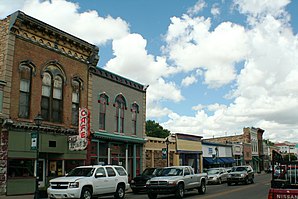Las Vegas (New Mexico)
|
|
This article was on the basis of substantive defects quality assurance side of the project USA entered. Help bring the quality of this article to an acceptable level and take part in the discussion ! A closer description on the resolving issues is missing. |
| Las Vegas | |
|---|---|
 Downtown Las Vegas |
|
| County and state location | |
| Basic data | |
| Foundation : | 1835 |
| State : | United States |
| State : | New Mexico |
| County : | San Miguel County |
| Coordinates : | 35 ° 36 ′ N , 105 ° 13 ′ W |
| Time zone : | Mountain ( UTC − 7 / −6 ) |
| Residents : | 14,565 (as of: 2000) |
| Population density : | 746.9 inhabitants per km 2 |
| Area : | 19.5 km 2 (approx. 8 mi 2 ) of which 19.5 km 2 (approx. 8 mi 2 ) is land |
| Height : | 1958 m |
| Postcodes : | 87701, 87745 |
| Area code : | +1 505 |
| FIPS : | 35-39940 |
| GNIS ID : | 0915788 |
| Website : | www.lasvegasnm.gov |
Las Vegas is a city in the northeast of the US state New Mexico in San Miguel County . Las Vegas is the county seat , has 14,565 inhabitants and covers an area of 19.5 km². The city lies on the Gallinas River . Las Vegas is also home to New Mexico Highlands University and West Las Vegas High School . "Las Vegas" means: "the floodplains"; the full Spanish name of the city, namely: "Nuestra Señora de los Dolores de Las Vegas Grandes", means in German about: "Our Lady of Sorrows from the Great Meadows".
history
New Mexico was part of Mexico from 1821 to 1846 . Las Vegas was founded in 1835 after the Mexican government granted land to a group of settlers there. The city was laid out in the traditional Spanish colonial style around a central main square. The buildings surrounding the plaza could serve as a fortress in the event of an attack.
Las Vegas soon flourished as a stopover on the Santa Fé Trail , through which much of the trade with the American settlement centers on the Missouri River was carried out. As a result, Las Vegas came increasingly not only under economic, but above all also under political and cultural influence of the USA.
In 1846, during the Mexican-American War (1846–1848), US General Stephen W. Kearny gave a speech in the Plaza of Las Vegas, in which he claimed New Mexico for the United States. As a result of the war, New Mexico fell to the United States with the Guadalupe-Hidalgo Peace Treaty of 1848, but did not become a US state until 1912. Fort Union , now a US national memorial , was built 20 miles northeast of Las Vegas in 1852 .
In 1879 the tracks of the Atchison, Topeka and Santa Fe Railway (ATSF) passed the first settlement core of (West) Las Vegas about 1.6 km east of the plaza. At the train station, East Las Vegas is quickly forming a second settlement core. Thanks to its rail links, Las Vegas was booming and soon developed into one of the largest cities in the region. At the turn of the 19th and 20th centuries, Las Vegas already had various advanced facilities, such as an electrified tram, the Duncan Opera House on the northeast corner of the intersection of 6th Street and Douglas Avenue, the Carnegie Library, built in 1903 , the hotel "La Castaneda" built in 1898 by the Fred Harvey Company (which specializes in railway catering), a psychiatric clinic (the "New Mexico Insane Asylum") and the "New Mexico Normal School", the forerunner of today's New Mexico Highlands University . Since the US railroad industry began to decline in the 1950s, the population of Las Vegas has remained relatively constant.
Movies
Parts of the film Ballad by Gregorio Cortez (1983) were filmed in and around Las Vegas. Many western films have also been shot in the area. Parts of the film Vampires were also shot here. In addition, the city was briefly in Freedom Downtime , a film about the hacker Kevin Mitnick . 2010 some scenes of the film were date rotated in the region around Las Vegas, as well as parts of No Country for Old Men (2007).
Sons of the city
- Ezequiel Cabeza de Baca (1864–1917), politician
- Jesse L. Boyce (1881–1961), politician
- Woolford Bales Baker (1892-1993), biologist
- Bert Forbes, computer technician

